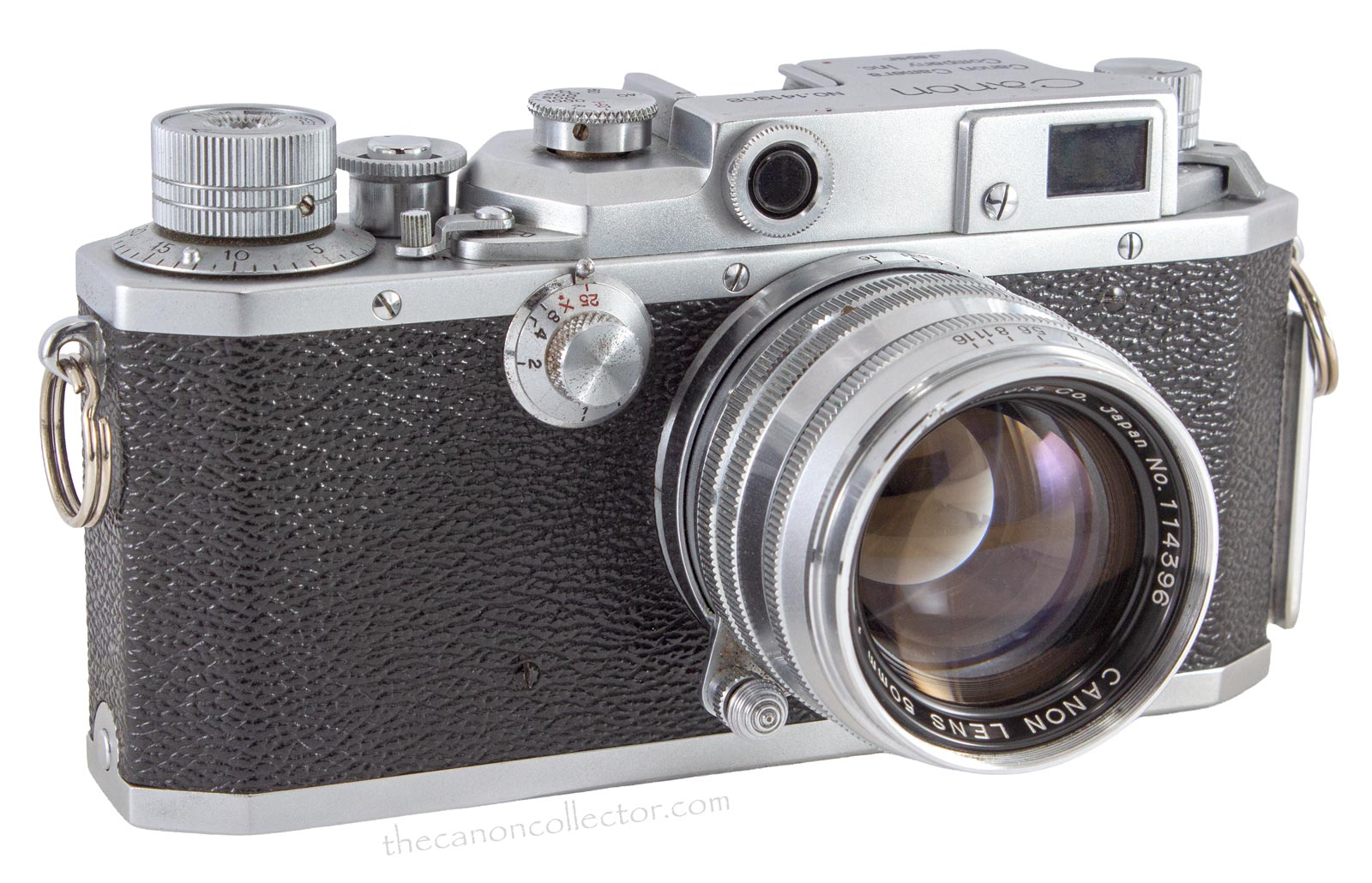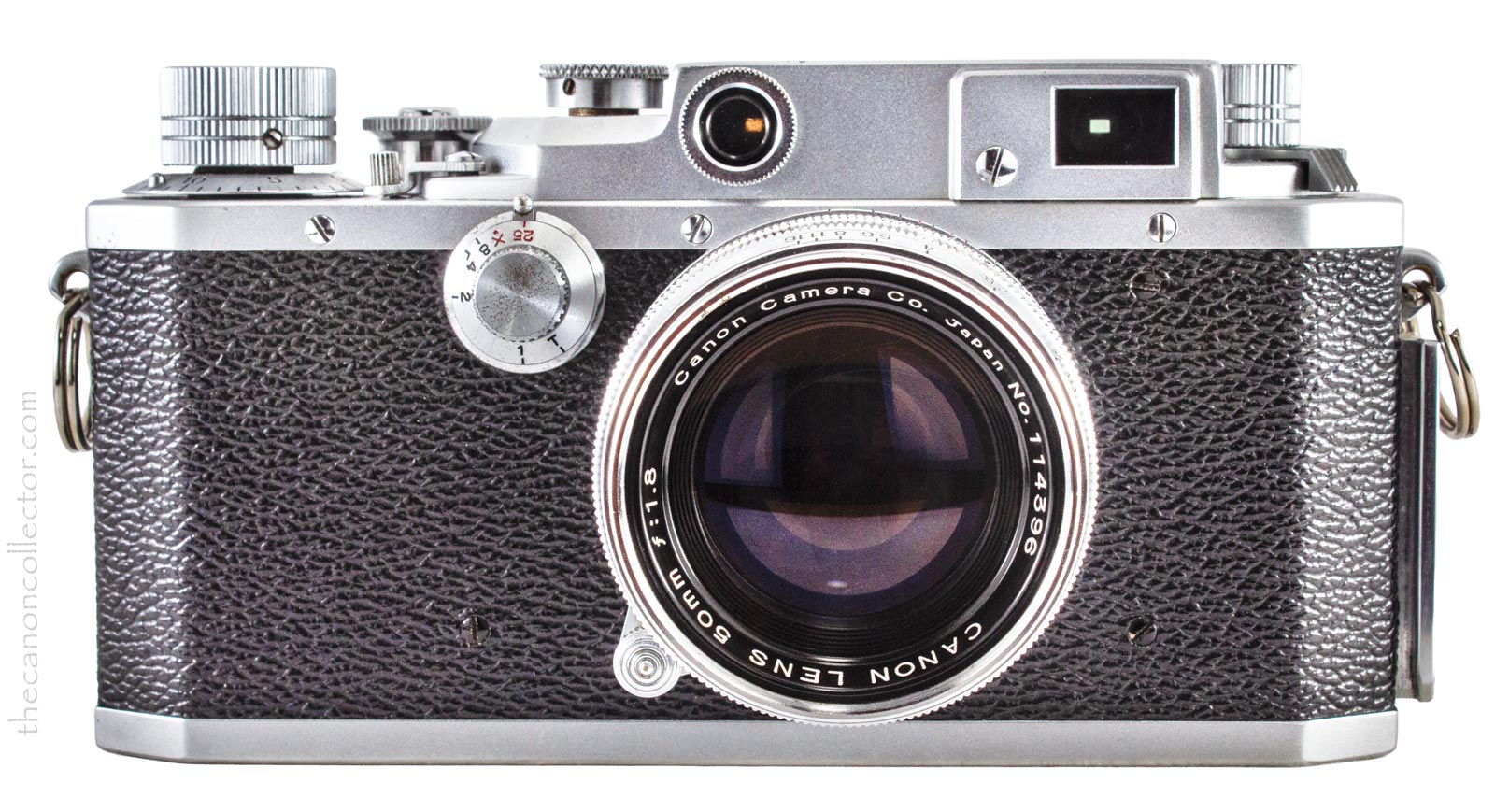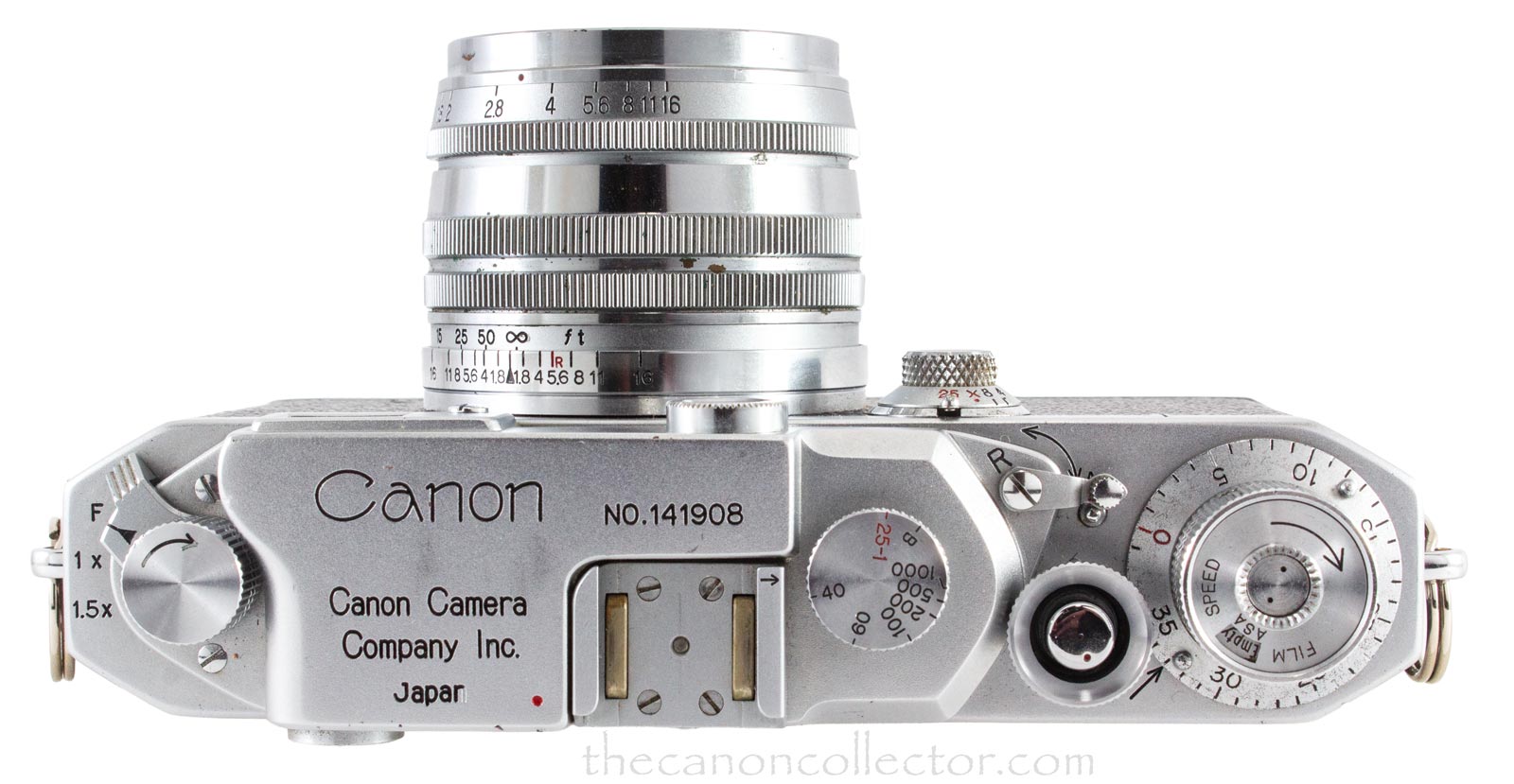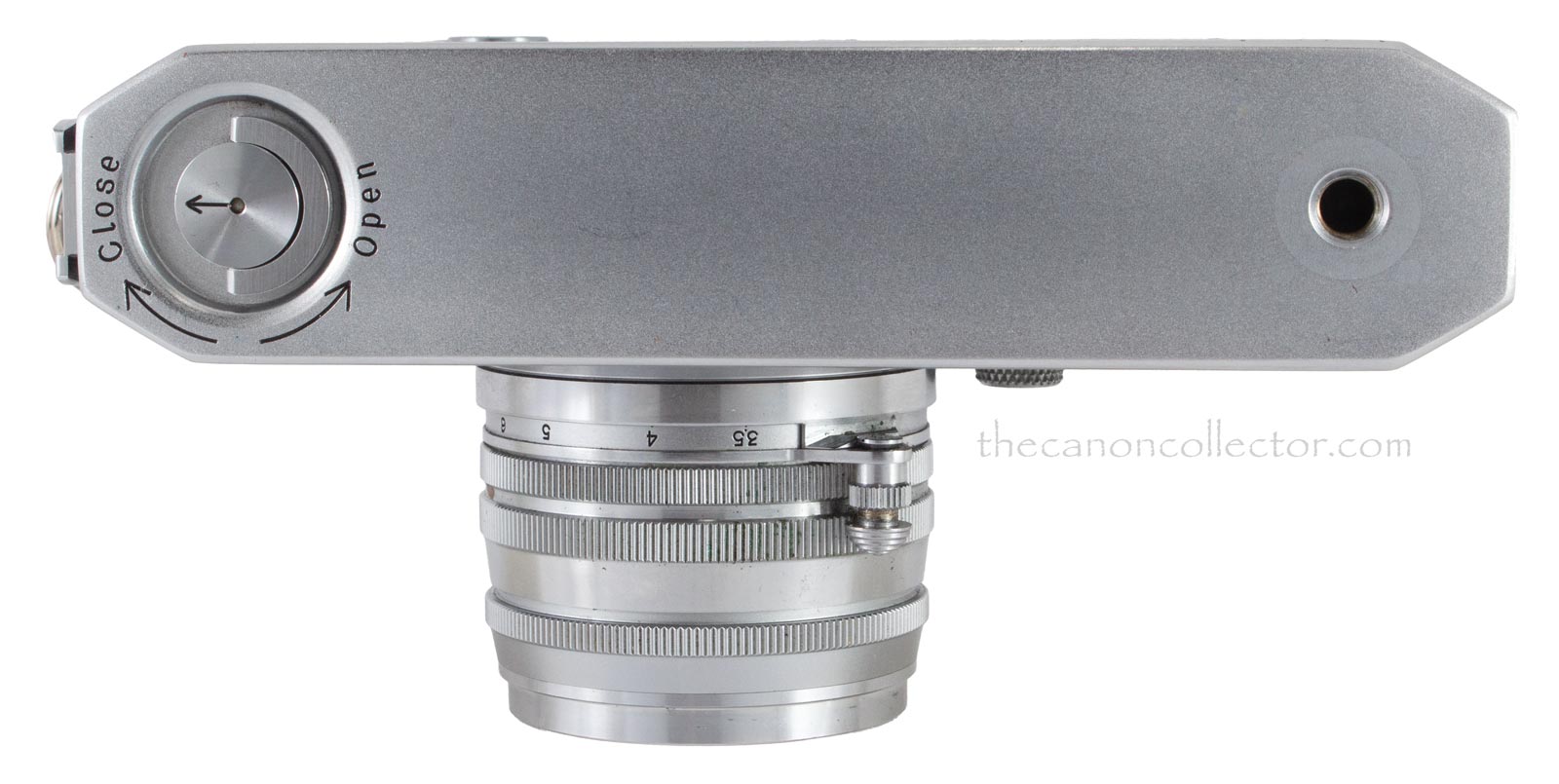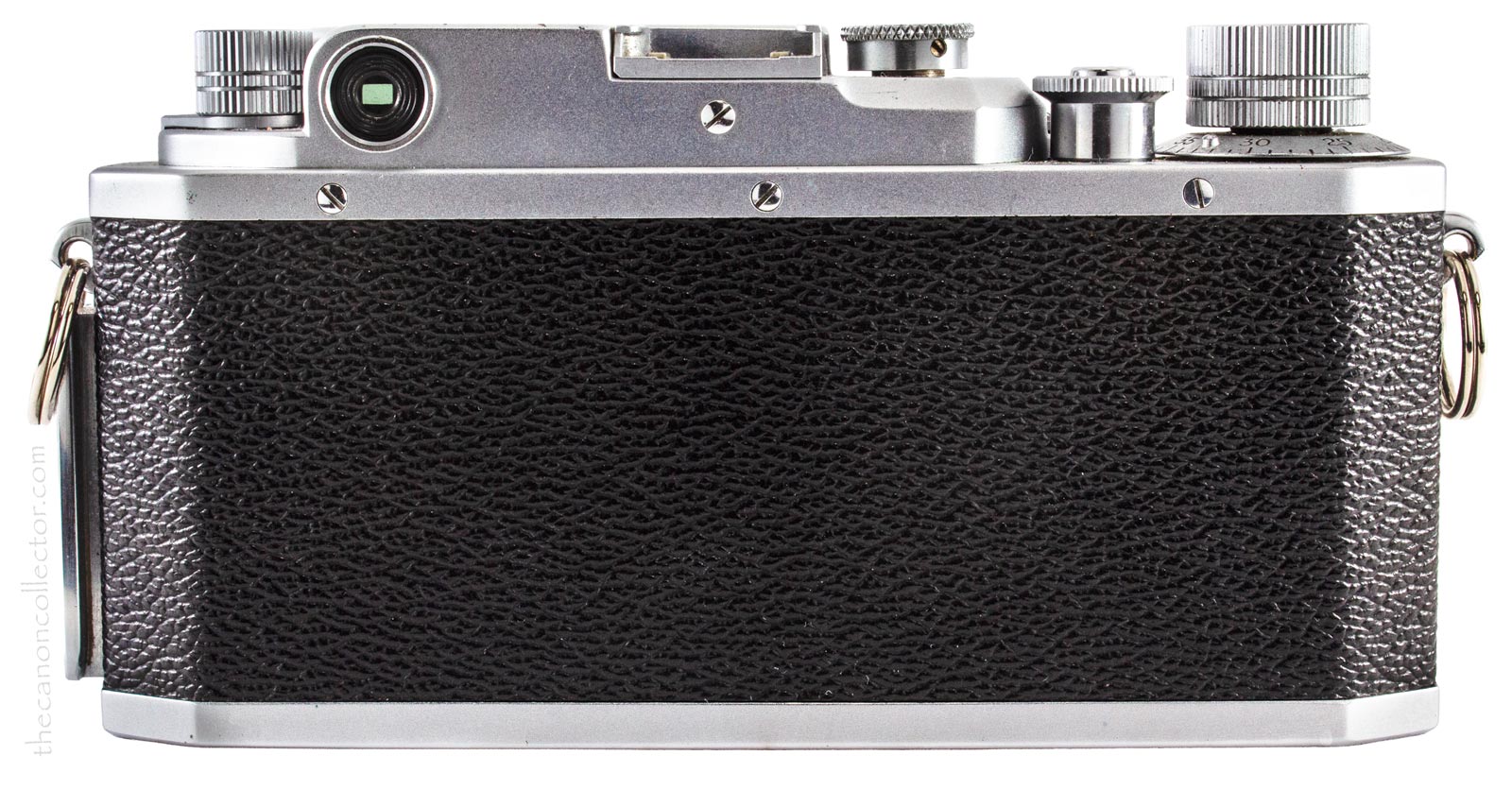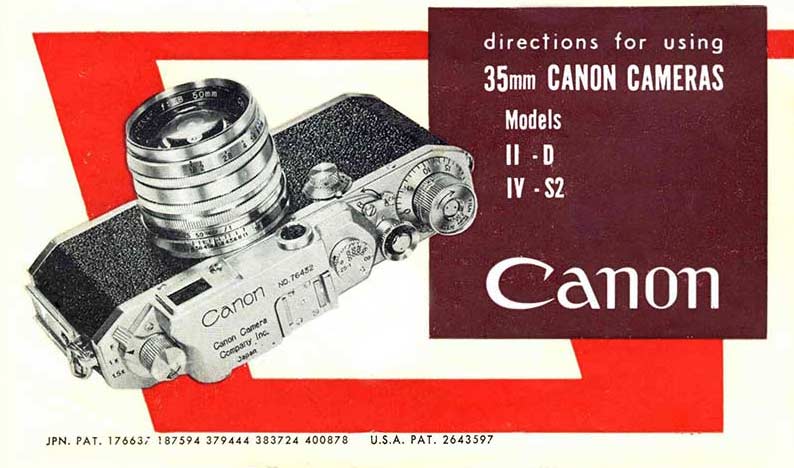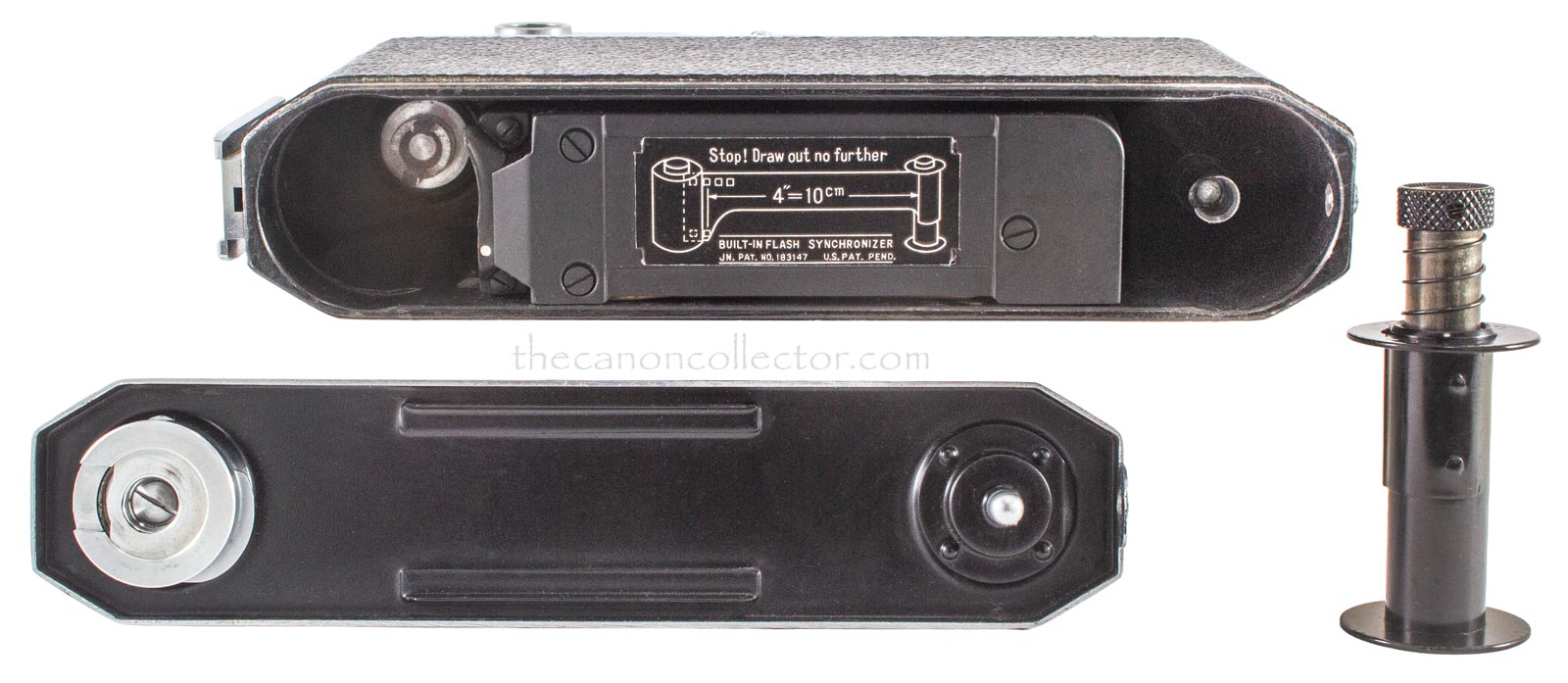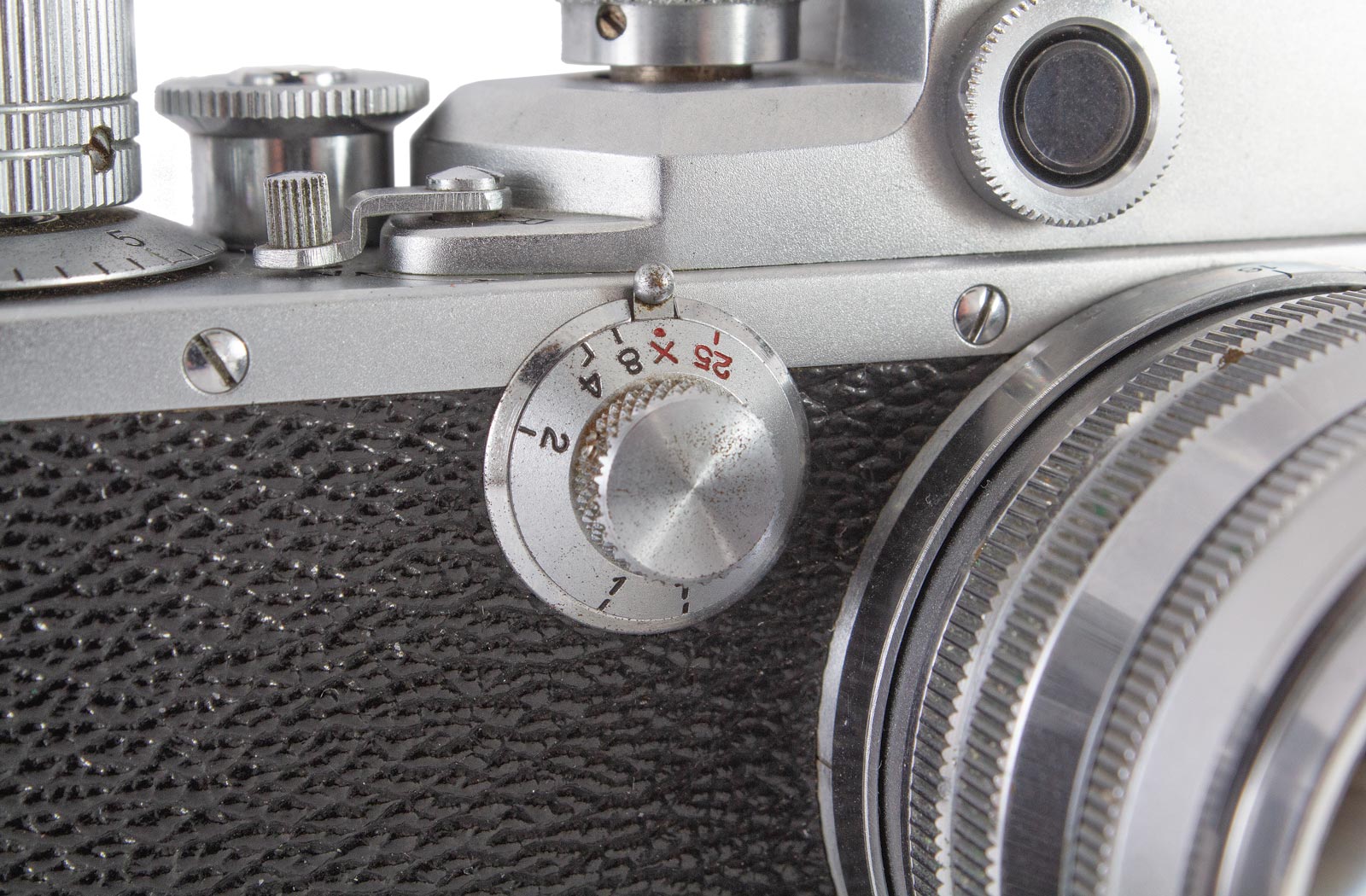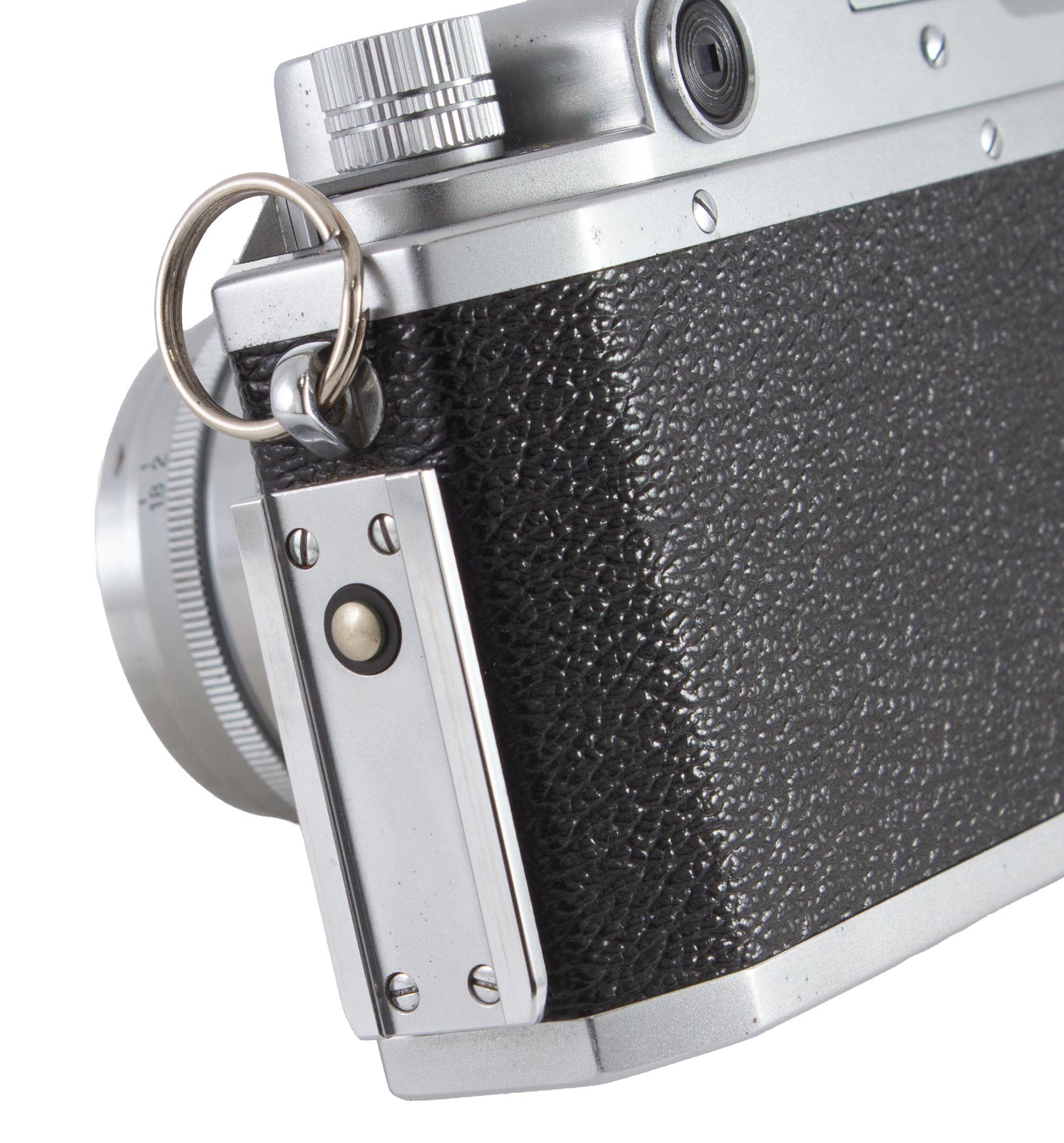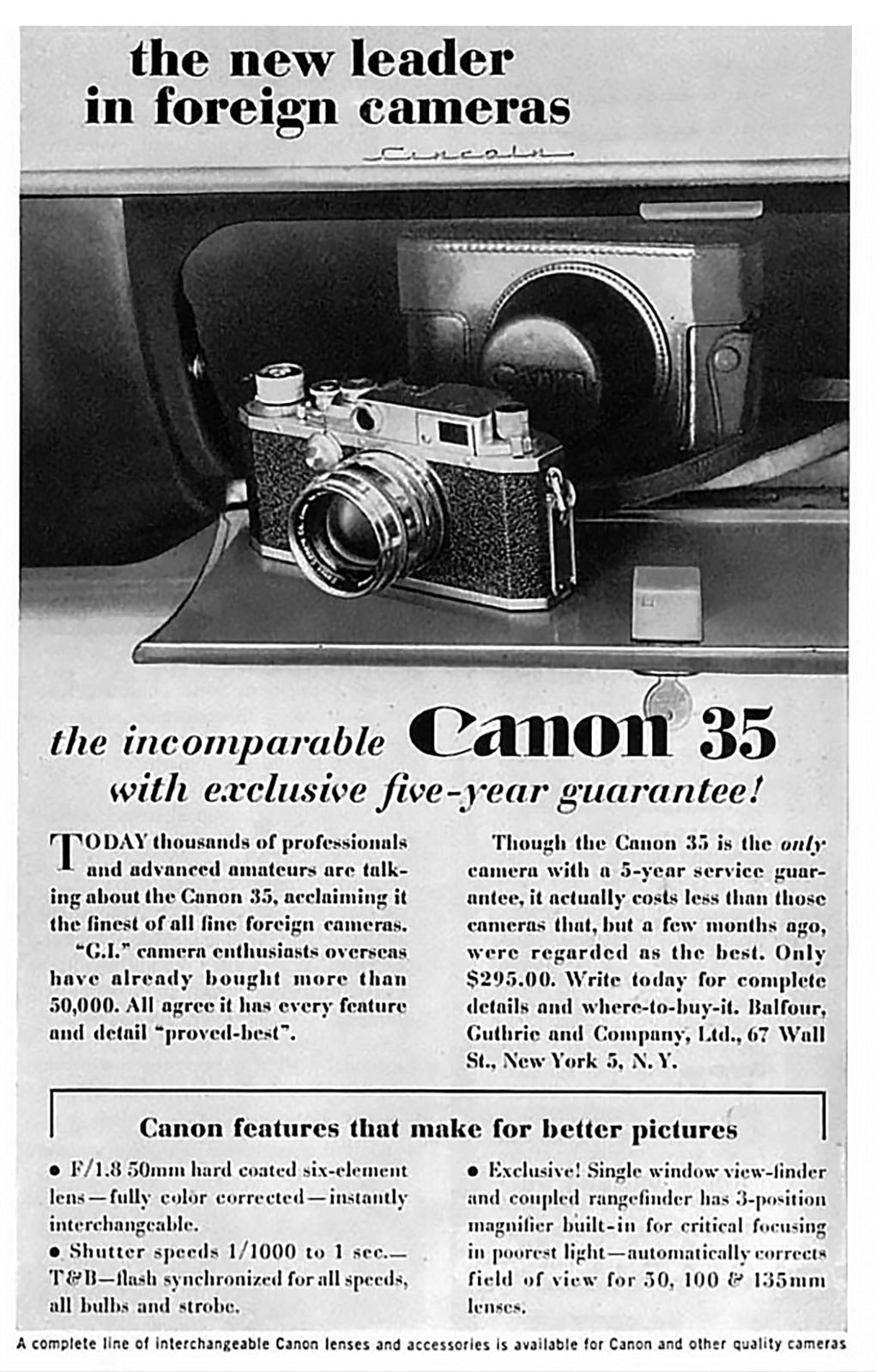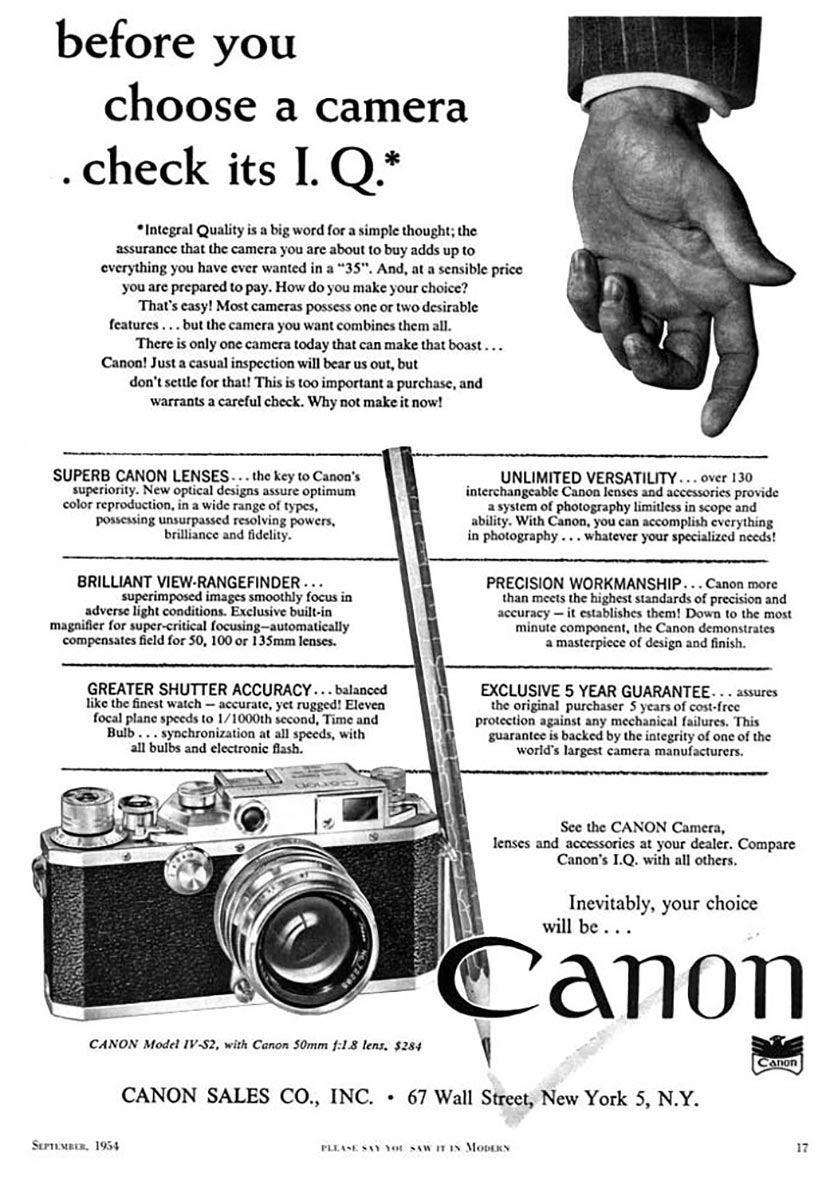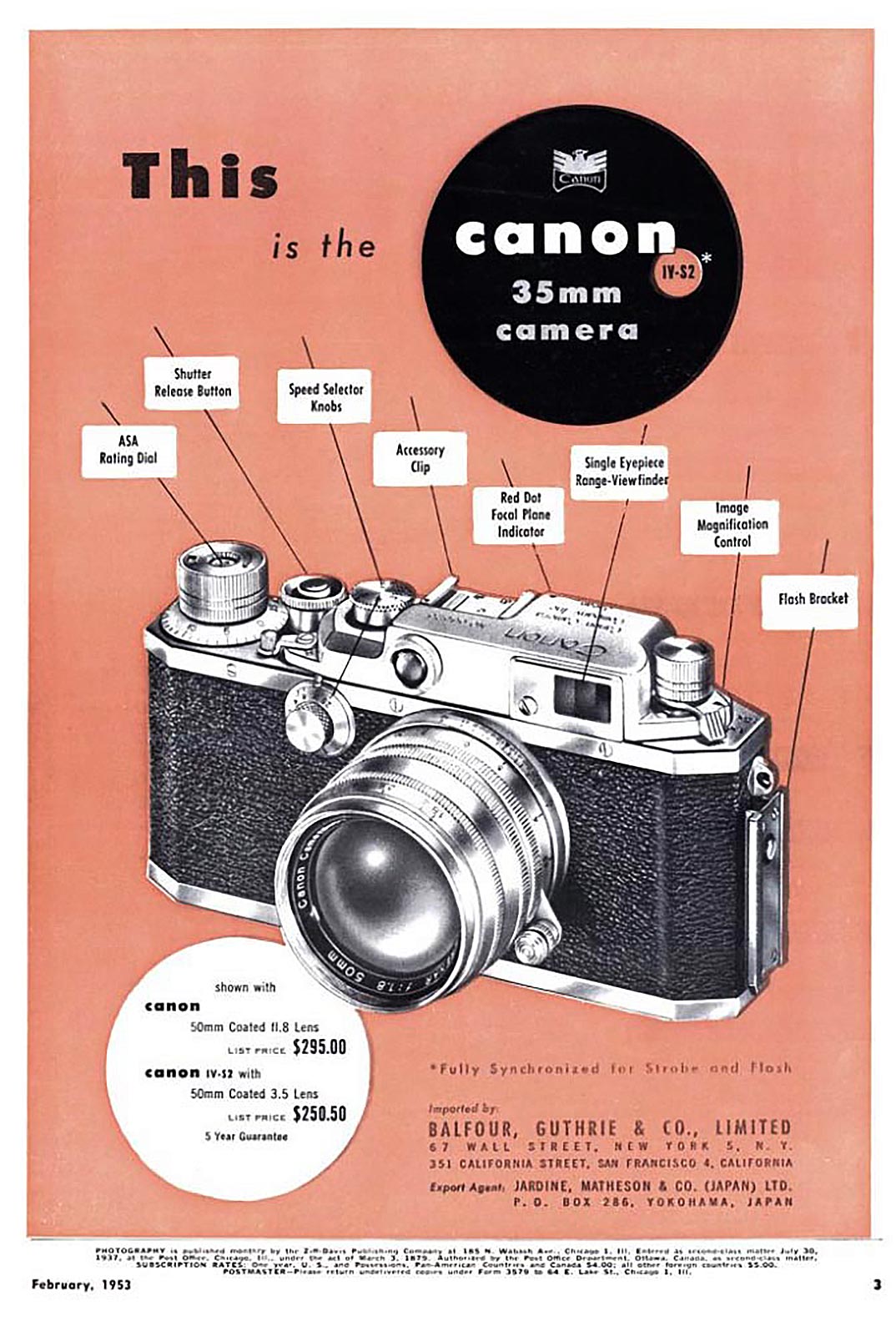This is my Model IV Sb, marketed as the IV S2 in the United States,
(Ser. No. 141908) which is essentially a Model IV S with two modifications. The 50mm f1.8 Canon Lens was the usual lens sold with this camera. The split rings in the strap lugs are not original Canon equipment. I have added them for my camera strap when I shoot with this camera.
Canon Model IV-Sb
also called the IV-S2
Canon rangefinder model designations are notoriously difficult to figure out and keep straight. Some changes were made during production but never mentioned. Other changes were made, some that seemed very minor, and model numbers were changed. All very confusing!
The Model IV was just a Model III with flash bulb sync through the added flash rail at the left end of the camera. The Model IV F was a Model IV with a universal thread lens mount and a sheet
metal shutter “crate”. The Model IV S was a IV F with a die cast “crate”. And finally, the Model IV Sb was a Model IV S with a lock on the slow speed dial and sync for strobe lights in addition to flash bulbs.
It was with the Model IV Sb that Canon made an attempt to break out of the home market selling just to their own people and occupying soldiers. They mounted a major advertising campaign in the United States, where the IV Sb was called the IV S2, selling through their agents Jardine, Matheson & Co. and Balfour, Guthrie & Co..
This campaign was a success resulting in record sales for the IV Sb with around 34,975 units produced. In Peter Dechert’s opinion, the IV Sb was the second most important rangefinder camera for Canon, after the Model IIb.
In this image the Model is distinguished from earlier Model IV’s by the lock on the slow speed dial and the “X” setting between the 1/25th and 1/8th positions on the dial. However, some later rangefinder models had these same features.
The Model IV Sb was released by Canon in December of 1952 according to the Canon Museum. It was usually marketed with the Canon Lens 50mm f/1.8. At the time of introduction Canon also announced that they were discontinuing the use of the “Serenar” name and simply using “Canon Lens” to brand their lenses. However, if other lenses were ordered with the IV Sb they may have been pulled from stocks of existing Serenar lenses.
The IV Sb was intended as a successor to the IV S. Canon always referred to it as the “IV Sb” but for some reason when marketing it overseas they called it the IV S2. This was the first Canon camera to be sold into multiple overseas markets.
Technically it was identical to the IV S. It had a two axis focal plane shutter and universal thread mount. Shutter speeds ran from B to 1/1000th in two dials with the change over point at 1/25th of a second.
We have a Newsletter
There is a Newsletter for thecanoncollector.com to keep you up to date on what we are posting. Try it!
The top deck of the IV Sb the same as that on the IV S and IV F. It is shown here with the Canon Lens 50mm f/1.8 lens.
The bottom of the IV Sb is the standard bottom plate found on most Barnack styled cameras. There is simply the key to unlock the bottom plae to remove it and the tripod mount at the other end.
Two modifications set this camera apart from the earlier model. Firstly a small lock was added to the slow speed dial so that it would stay securely at the 1/25th position when the user was relying on the high speed dial on the top deck, which was most of the time. The lock only secured the 1/25th position and the other speed settings were not affected by the lock.
The second change was the addition of a shutter position for strobe light synchronization. The IV S was synchronized for certain flash bulbs listed in the Canon Flash Unit Instructions for speeds from about 1/40th to 1/1000th. Particular bulbs had to be used because the ignition timing had to be adjusted to the delay in the ignition of the flash bulb and the duration of the flash.
Strobe or electronic flash units are different in that they fire almost instantaneously and the flash duration is extremely short. As a result, the flash must be timed to a shutter speed that has both curtains fully open at the moment of discharge. On the Model IV Sb this is about 1/15th of a second. This speed is marked by a red “X” on the slow speed dial between the 1/8th and 1/25th positions.
This seems a very slow speed but the illumination of the subject comes from the strobe light and not ambient illumination so ghosting, which can occur in some situations, is usually not a problem.The Flash Unit attaches to the camera via the flash rail on the left end of the camera introduced with the Model IV in 1951. The flash contact is the button in the middle of the Rail which serves for both flash units and strobe units.
Flash photography with the IV Sb is more fully described in the Camera User Instructions. The Instructions are in English and remember that the IV S2 is the same camera.
The back of the camera has no controls that require attention. Of course, being a Barnack style camera the back does not open.
In terms of sales, the IV Sb was Canon’s third most popular rangefinder camera, 34,975 units, after the Model P, 87,875 units, and the Model 7, 137,250 units. It was the IV Sb that launched Canon into the international market which explains why Peter Dechert felt this camera was so pivitol for Canon.
This was the first Canon rangefinder camera to be found in black finish, but they are rare. Two are known to exist, one in the possession of Canon and one in a private collection. The actual details surrounding their creation appear to be lost. But be on the lookout. There may be others out there. But telling an original factory exmple from a “repaint” may be very difficult.
The bottom of the camera is removeable like with most Barnack style 35mm cameras. The spring loaded take-up spool is a Canon feature that greatly simplifies the loading and unloading of the camera. The diagram on the bottom of the shutter “crate” is important because if you do not follow it the camera is almost impossible to load. The User Manual for the camera goes into greater detail about this. Leica II and III’s have the same issue and Leica even made a metal template to guide users in cutting the film correctly.
Using the Model IV Sb
If you love to shoot film in old rangefinder cameras then this camera will be a joy. Good condition working examples are easily found on the second hand market at
reasonable prices and lenses are plentiful. This camera uses a “Universal Thread” lens mount but what Canon really means is that the mount is the standard M39 thread mount of the Leica camera. Not only will Leitz lenses fit on this camera but the rangefinder on the Canon is compatible and the lenses will focus accurately. This means that the available lens pool is essentially unlimited.
Care must be taken in loading this camera. The tongue on the film must be cut as the manual points out. The diagram on the bottom of the shutter “crate” also shows the correct shape. The problem arises that if the leader is too short the film will not slide easily over the sprocket wheel and the film will become deformed and not feed correctly. Save yourself the headache and do as instructed. If you do then film loading is a snap.
Everything on this camera is manual. Before shooting you advance the film three frames to ensure that unexposed film is behind the lens (this also ensures you have enough film leader when you are developing your film). You then manually set the film counter to 1 and you enter the film speed in the reminder wheel on top of the film winder knob. You then set your desire f/ Stop and Aperture after using your external hand held light meter. Then you focus and finally you are ready to press the shutter. What fun!
The IV Sb is not large. It fits easily in the hand and feels solid and well made. No loose parts. I like using the Elmar style collapsible f/3.5 50mm Serenar. It is not the correct lens for this camera but it is light and compact making the whole package easy to carry. The 50mm f/1.8 Canon Lens shown in these pictures is the correct lens for the camera but it seems a little over sized for me. But no matter what lens you use, this is a great camera.
Accessories I use are a lens filter to protect the front element and a lens hood. You can see the large split rings I have on the camera for my neck strap which I always use which is another protection for the camera. The only other accessory I use is a Camera Holder if I am going to mount the camera on a tripod. And of course Canon made a Self Timer for it and a cable release. And all of that would have constituted a complete camera system in 1952.
The Slow Speed Dial lock is the small knob at the 12 o’clock position. It locks the dial at the “25” position. Press it towards the body and you can turn the dial to the other settings which have a detent but do not lock. The “X” position is the setting for strobe use and corresponds to around 1/15th second.
This ad is for the “Canon 35” which could refer to any of Canon’s cameras. It refers to “G.I.’s” and says that the camera has flash and strobe syncronization. Finally, the slow speed dial in the picture shows the small lock device.
This is a later ad from September 1954 for the IV Sb, although it is refered to as the IV S2. Same camera! Notice the reference to G.I. sales is gone but the ad does not emphasise the model. It is a generic ad for Canon generally.
This website is the work of R. Flynn Marr who is solely responsible for its contents which are subject to his claim of copyright. User Manuals, Brochures and Advertising Materials of Canon and other manufacturers available on this site are subject to the copyright claims and are the property of Canon and other manufacturers and they are offered here for personal use only.

